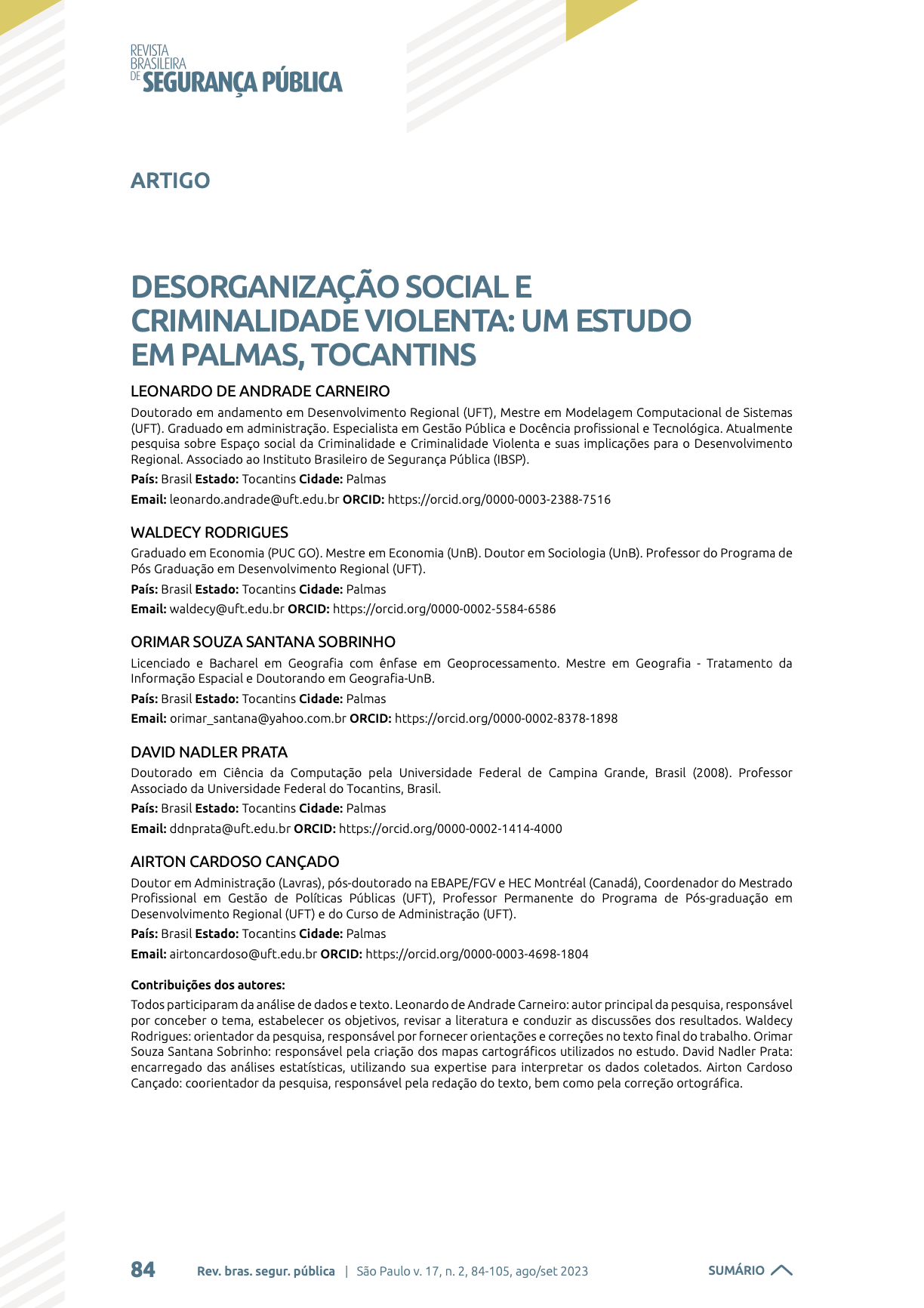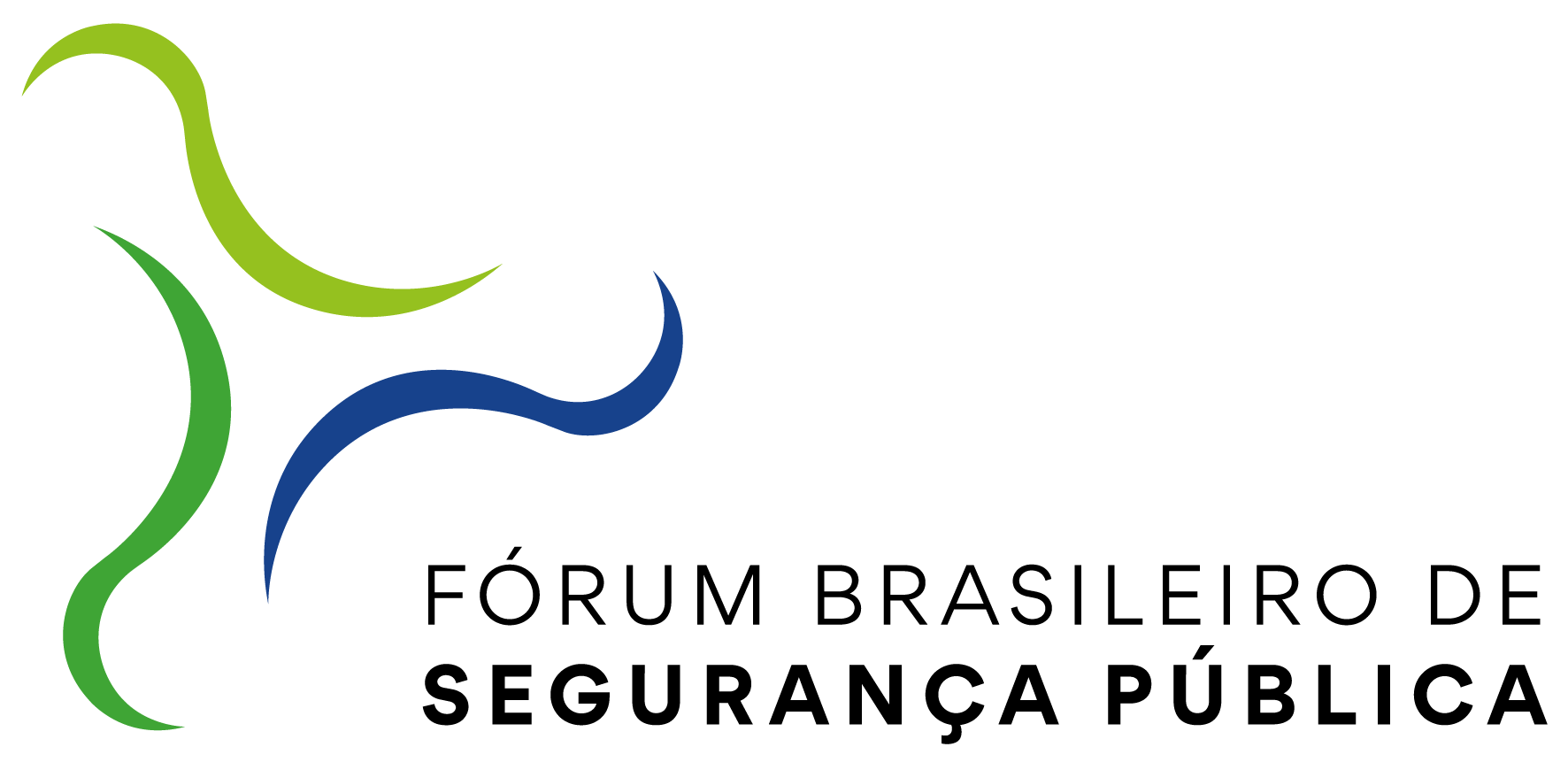Social disorganization and violent criminality
a study in palmas, tocantins
DOI:
https://doi.org/10.31060/rbsp.2023.v17.n2.1546Keywords:
Social disorganization, Violent criminality, Urban spacesAbstract
This paper aims to analyze aspects of violent crime in Palmas, capital of the state of Tocantins. It starts from the scope of the “Social Disorganization Theory” to reflect on the relations between urban growth and the concentration of violent criminality in the urban space of this city. This theoretical and conceptual subsidy guided the survey of secondary data, prioritizing the databases and digital cartographic bases made available by the IBGE, the Integrated System of Operations of the Military Police of Tocantins, and the Brazilian Public Security Forum. Statistical techniques and database construction were used for the elaboration of cartographic documents to analyze the relations between violent criminality and socioeconomic indicators and urban attributes. In this sense, the study showed that the variables income, literacy, race, basic urban services, especially the presence of public lighting, are contributory factors to the concentration of violent crimes in Palmas. Particularly, the crime of robbery is related to spatial segregation and the existing urban voids. From this perspective, violent crime in Palmas is determined mainly by the absence of public policies, of income and formal social control.
Downloads
References
ADORNO, S. Exclusão socioeconômica e violência urbana. Sociologias, Porto Alegre, ano 4, n. 8, p. 84-135, jul./dez. 2002.
AQUINO, Á.; GULLO, S. Violência urbana: um problema social. Tempo Social, v. 10, n. 1, p. 105-119, maio 1998.
BEATO FILHO, C. C. Desigualdade, desenvolvimento socioeconômico e crime. In: HENRIQUES, R. (Org.). Desigualdade e pobreza no Brasil. Rio de Janeiro: Ipea, 2000, p. 385-405.
BEATO FILHO, C. C. Determinantes da criminalidade em Minas Gerais. Revista Brasileira de Ciências Sociais, v. 13, n. 37, p. 74-87, 1998.
BEATO FILHO, C. C.; ASSUNÇÃO, R. M.; SILVA, B. F. A.; MARINHO, F. C.; REIS, I. A.; ALMEIDA, M. C. M. Conglomerados de homicídios e o tráfico de drogas em Belo Horizonte, Minas Gerais, Brasil, de 1995 a 1999. Cadernos de Saúde Pública, v. 17, n. 5, p. 1163-1171, out. 2001.
BEATO FILHO, C. C.; PEIXOTO, B. T.; ANDRADE, M. V. Crime, oportunidade e vitimização. Revista Brasileira de Ciências Sociais, v. 19, n. 55, p. 73-89, jun. 2004.
BEATO, C.; ZILLI, L. F. A estruturação de atividades criminosas: um estudo de caso. Revista Brasileira de Ciências Sociais, v. 27, n. 80, p. 71-88, out. 2012.
BREETZKE, G. D. Modeling violent crime rates: A test of social disorganization in the city of Tshwane, South Africa. Journal of Criminal Justice, v. 38, n. 4, p. 446-452, jul./ago. 2010.
BRITO, E. P. Planejamento, especulação imobiliária e ocupação fragmentada em Palmas. Caminhos de Geografia, Uberlândia, v. 11, n. 34, p. 93-104, jun. 2010.
BRUINSMA, G. J. N.; PAUWELS, L. J. R.; WEERMAN, F. M.; BERNASCO, W. Social disorganization, social capital, collective efficacy and the spatial distribution of crime and offenders: An empirical test of six neighbourhood models for a Dutch city. The British Journal of Criminology, v. 53, n. 5, p. 942-963, set. 2013. Doi: https://doi.org/10.1093/bjc/azt030.
BURSIK, JR.; ROBERT, J. Social disorganization and theories of crime and delinquency: Problems and prospects. Criminology, v. 26, n. 4, p. 519-552, nov. 1988.
BURSIK JR.; ROBERT, J.; GRASMICK, H. G. Economic deprivation and neighborhood crime rates, 1960-1980. Law & Society Review, v. 27, n. 2, p. 263, 1993.
CARDIA, N.; ADORNO, S.; POLETO, F. Homicídio e violação de direitos humanos em São Paulo. Estudos Avançados, v. 17, n. 47, p. 43-73, abr. 2003.
CARNEIRO, L. A.; ROCHA SILVA, M. A. Desafios e perspectivas de políticas públicas na redução de crimes violentos letais intencionais no norte do Brasil. Research, Society and Development, v. 9, n. 11, e61791110178, 2020.
CERQUEIRA, D.; LOBÃO, W. Determinantes da criminalidade: arcabouços teóricos e resultados empíricos. Dados, v. 47, n. 2, p. 233-269, 2004. Doi: https://doi.org/10.1590/S0011-52582004000200002.
CERQUEIRA, Daniel Ricardo de Castro; LOBÃO, Waldir Jesus Araújo; CARVALHO, Alexandre Xavier Ywata de. O jogo dos sete mitos e a miséria da segurança pública no Brasil. 2005.
COHEN, L. E.; FELSON, M. Social change and crime rate trends: A routine activity approach. American Sociological Review, v. 44, n. 4, p. 588-608, ago. 1979. Doi: https://doi.org/10.2307/2094589.
CORIOLANO, G. P.; RODRIGUES, W.; OLIVEIRA, A. F. Estatuto da Cidade e seus instrumentos de combate às desigualdades socioterritoriais: o Plano Diretor Participativo de Palmas (TO). urbe. Revista Brasileira de Gestão Urbana, v. 5, n. 2, p. 131-145, dez. 2013. Doi: https://doi.org/10.7213/urbe.05.002.AC04.
DURKHEIM, É. As Regras do Método Sociológico. Tradução: Pietro Nassetti. São Paulo: Martin Claret, 2004.
ESCOBAR, G. El uso de la teoría de la desorganización social para comprender la distribución de homicidios en Bogotá, Colombia. Revista INVI, v. 27, n. 74, p. 21-85, maio 2012. Doi: http://dx.doi.org/10.4067/S0718-83582012000100002.
FERRAZ, José Neto. ESCOLA DE DADOS. Tutorial: Dados como classificá-los? In: O eu analítico. 2019.
FILHO, N. S. P. Manual Esquemático de Criminologia. São Paulo: Saraiva, 2018.
FÓRUM BRASILEIRO DE SEGURANÇA PÚBLICA (FBSP). 14º Anuário Brasileiro de Segurança Pública. [recurso eletrônico].
FÓRUM BRASILEIRO DE SEGURANÇA PÚBLICA (FBSP). Anuário Brasileiro de Segurança Pública. 2020.
GULMA, U. L.; EVANS, A.; HEPPENSTALL, A.; MALLESON, N. Diversity and burglary: Do community differences matter?. Transactions in GIS, v. 23, n. 2, p. 181-202, abr. 2019. Doi: https://doi.org/10.1111/tgis.12511.
INSTITUTO BRASILEIRO DE GEOGRAFIA E ESTATÍSTICA (IBGE). Censo Demográfico 2010.
INSTITUTO BRASILEIRO DE GEOGRAFIA E ESTATÍSTICA (IBGE). Cidades e Estados. 2022.
INSTITUTO BRASILEIRO DE GEOGRAFIA E ESTATÍSTICA (IBGE). Geociências. Malhas Digitais.
IPEA – INSTITUTO DE PESQUISAS AVANÇADOS; FBSP – FÓRUM BRASILEIRO DE SEGURANÇA PÚBLICA. Atlas da violência 2019. Brasília; Rio de Janeiro; São Paulo: Ipea; FBSP, 2019.
JONES, R. W.; PRIDEMORE, W. A. Toward an integrated multilevel theory of crime at place: routine activities, social disorganization, and the law of crime concentration. Journal of Quantitative Criminology, v. 35, n. 3, p. 543-572, 2019. Doi: https://doi.org/10.1007/s10940-018-9397-6.
KUBRIN, C. E. Social disorganization theory: Then, now, and in the future. Handbook on Crime and Deviance. New York, 2009, p. 225-236.
LIMA, R. K.; MISSE, M.; MIRANDA, A. P. M. Violência, criminalidade, segurança pública e justiça criminal no Brasil: uma bibliografia. BIB, Rio de Janeiro, n. 50, p. 45-123, 2000.
OLIVEIRA, A. S. A violência e a criminalidade como entraves à democratização da sociedade brasileira. Caderno CRH, v. 16, n. 38, 2003. Doi: http://dx.doi.org/10.9771/ccrh.v16i38.18622.
OLIVEIRA, C. A Criminalidade e o tamanho das cidades brasileiras: um enfoque da economia do crime. Anais, XXXIII Encontro Nacional de Economia, ANPEC – Associação Nacional dos Centros de Pós-Graduação em Economia, Natal/RN, dez. 2005.
OLIVEIRA, S. G. S.; GUEDES, E. F; ZEBENDE, G. F. Vulnerabilidade Social e Criminalidade na Região Metropolitana de Salvador: Uma abordagem com métodos quantitativos. Conjuntura & Planejamento, n. 197, p. 79-93, jul./dez. 2019.
Organização das Nações Unidas. Agenda 2030 para o Desenvolvimento Sustentável. Nova York, 2015.
PARK, R. E.; BURGESS, E. W. The City: Suggestions for Investigation of Human Behavior in the Urban Environment. Chicago/IL: University of Chicago Press, 1925.
PINO, Angel. Violência, educação e sociedade: um olhar sobre o Brasil contemporâneo. Educação & sociedade, v. 28, p. 763-785, 2007. Doi: https://doi.org/10.1590/S0101-73302007000300007.
QUIVY, Raymond; VAN CAMPENHOUDT, Luc; SANTOS, Rui. Manual de investigação em ciências sociais. Lisboa: Gradiva, 1992.
REIS, Ilka Afonso; BEATO, Cláudio. Desigualdade, desenvolvimento socioeconômico e crime. Desigualdade e pobreza no Brasil, 2000.
ROBERT, J.; BURSIK JR.; WEBB, J. Community change and patterns of delinquency. American Journal of Sociology, v. 88, n. 1, p. 24-42, jul. 1982.
SAMPSON, R. J. Neighborhood family structure and the risk of personal victimization. In: BYRNE, J. M.; SAMPSON, R. J. (Eds.). The Social Ecology of Crime. New York, 1986, p. 25-46.
SAMPSON, R. J.; GROVES, W. B. Community structure and crime: Testing social-disorganization theory. American Journal of Sociology, v. 94, n. 4, p. 774-802, jan. 1989. Doi: https://doi.org/10.1086/229068.
SAMPSON, R. J.; RAUDENBUSH, S. W.; EARLS, F. Neighborhoods and violent crime: A multilevel study of collective efficacy. Science, v. 277, n. 5328, p. 918-924, ago. 1997.
SANTOS, J. T. O.; OLIVEIRA, A. M. Teoria da anomia e a aparente desorganização social nas ruas da cidade de Barreiras, oeste da Bahia: Uma análise dos fatores criminógenos. Campo Jurídico, v. 5, n. 2, p. 97-120, 2017.
SANTOS, M. A. F. Abordagens científicas sobre as causas da criminalidade violenta: Uma análise da Teoria da Ecologia Humana. LEVS, Marília, n. 17, p. 46-74, maio 2016. Doi: https://doi.org/10.36311/1983-2192.2016.v0n17.5972.
SILVA, B. F. A. Desorganização, oportunidade e crime: uma análise “ecológica” dos homicídios em Belo Horizonte. 2012. 174 p. Tese (Doutorado em Sociologia) – Faculdade de Filosofia e Ciências Humanas, Universidade Federal de Minas Gerais, Belo Horizonte, 2012.
SILVA, B. F. A. Social disorganization and crime: searching for the determinants of crime at the community level. Latin American Research Review, v. 49, n. 3, p. 218-230, 2014.
SILVA, V. C. P. Palmas, a última capital projetada do século XX: uma cidade em busca do tempo. São Paulo: Ed. Unesp, 2010. Doi: https://doi.org/10.7476/9788579830921.
STACY, C. P.; HO, H.; PENDALL, R. Neighborhood‐level economic activity and crime. Journal of Urban Affairs, v. 39, n. 2, p. 225-240, 2017. Doi: https://doi.org/10.1111/juaf.12314.
TAVARES, Ricardo et al. Homicídios e vulnerabilidade social. Ciência & Saúde Coletiva, v. 21, p. 923-934, 2016. Doi: https://doi.org/10.1590/1413-81232015213.12362015.
TEIXEIRA, L. F. C. A formação de Palmas. Revista UFG, Goiânia, v. 11, n. 6, 2017.
TOCANTINS. Polícia Militar Estado do Tocantins. Coordenação de Estatística e Análise Criminal – ASSEACRIM, 2020.
VIANA, E. Criminologia. 6 ed. Salvador: Juspodivm, 2019.
WAISELFISZ, J. J. Mapa da violência 2010: anatomia dos homicídios no Brasil. São Paulo: Instituto Sangari, 2010.
WANZINACK, C.; SOUZA, M. G.; LUCCHESI, V. O.; SIGNORELLI, M. C. Homicídios de mulheres e meninas no estado do Paraná: uma análise territorial retrospectiva de 2014 a 2018. Guaju, v. 6, n. 2, p. 140-156, jul./dez. 2020.
WICKES, R.; HIPP, J. R. The spatial and temporal dynamics of neighborhood informal social control and crime. Social Forces, v. 97, n. 1, p. 277-308, set. 2018. Doi: https://doi.org/10.1093/sf/soy026.
WORTLEY, S. et al. The review of the roots of youth violence: Literature reviews. Ministry of Children and Youth Services, 2008.

Published
How to Cite
Issue
Section
License
Copyright (c) 2023 Revista Brasileira de Segurança Pública

This work is licensed under a Creative Commons Attribution 4.0 International License.
Licensing
The Brazilian Journal of Public Security uses the Creative Commons License as a form of licensing for its published works. The license used follows the CC BY 4.0 - Attribution 4.0 International model.
To see the permitted rights please go to the full licence or to our Copyright and Licensing page.


